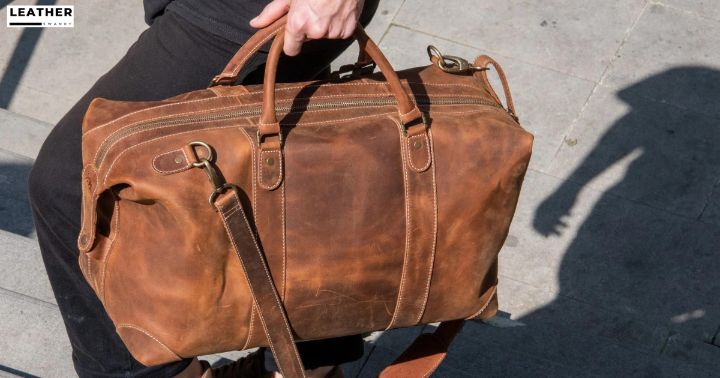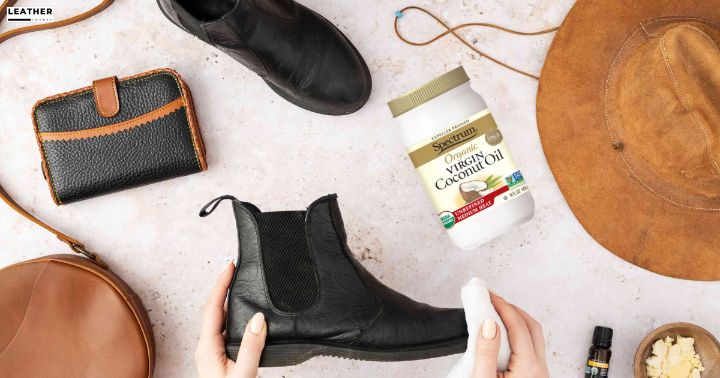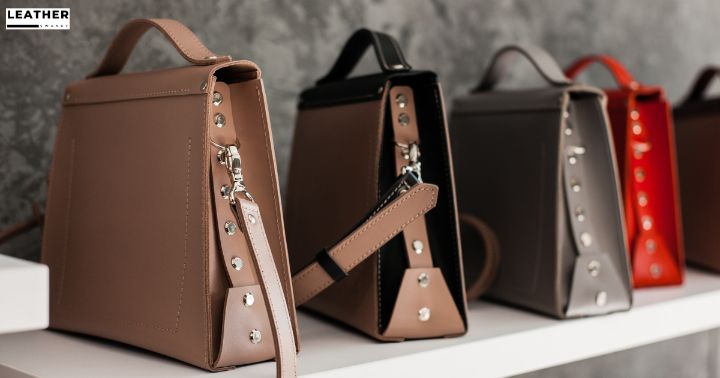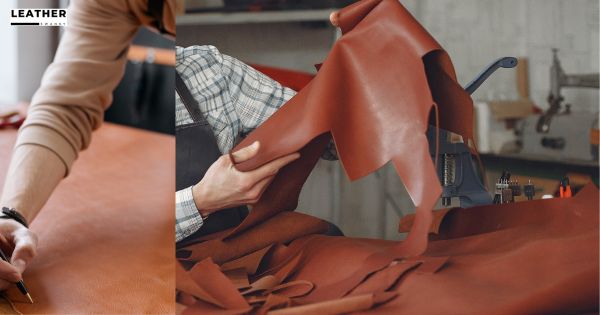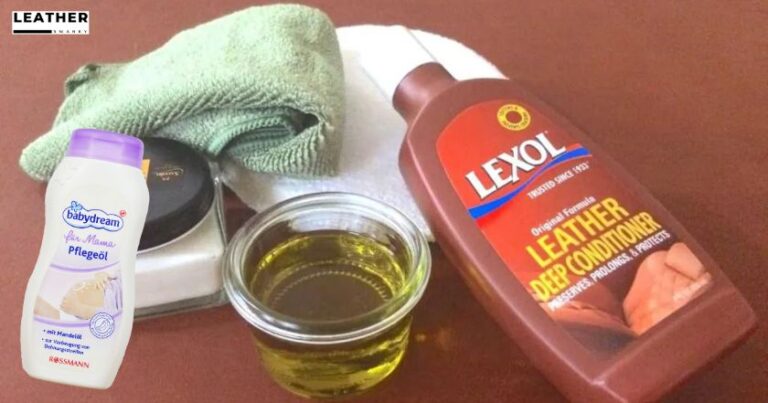How to Repair Cat Scratches on Leather? Explained in 7 Best Ways
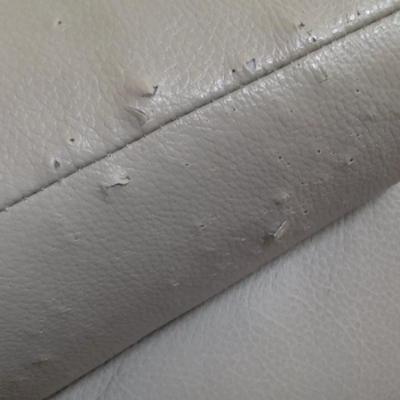
Leather is a beautiful and durable material, but cat scratches can be an eyesore. Don’t despair; repairing your leather is possible.
With the right supplies and techniques, you can make those scratches disappear in no time.
Repairing cat scratches on leather involves identifying the damage, assessing its severity, choosing the appropriate repair kit, cleaning and preparing the leather, applying the kit, using leather dye and sealant if needed, conditioning the leather, or opting for professional repair services.
In this article, we’ll discussed in detail how to repair cat scratches on leather whether they are minor, light, and deep by using various methods, from olive oil to professional repair kits.
Read on to learn more about how you can restore your leather quickly and easily.
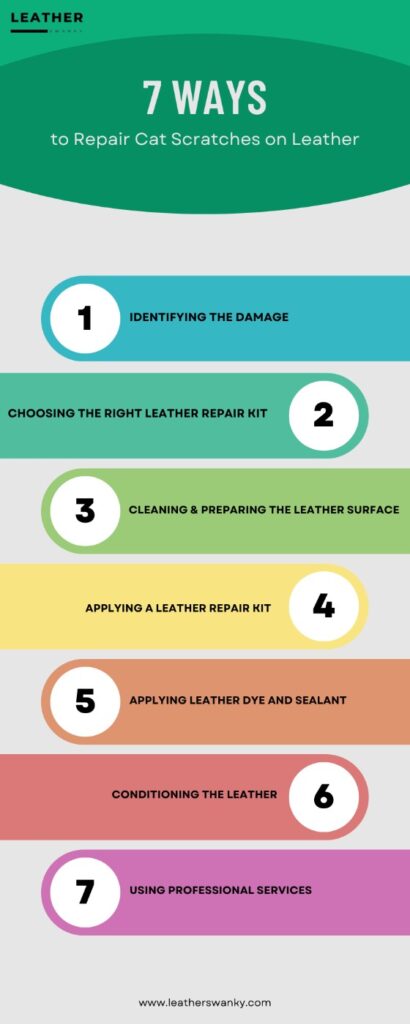
Jump to a Specific Section
- 1 Key Takeaways
- 2 Can You Repair Cat Scratch Marks From Leather?
- 3 Types of Cat Scratches on Leather
- 4 How to Repair Cat Scratches on Leather? 7 Ways
- 5 Repairing Minor, Light, and Deep Cat Scratches
- 6 Does Olive Oil Fix Cat Scratches on Leather?
- 7 Avoiding Future Damage
- 8 Final Thoughts
- 9 Frequently Asked Questions
- 9.1 How Long Does It Take to Repair Cat Scratches on Leather?
- 9.2 Is It Difficult to Repair Cat Scratches on Leather?
- 9.3 What Is the Best Way to Protect Leather so That Cat Scratches Don’t Occur?
- 9.4 What Other Materials Can Be Used to Repair Cat Scratches on Leather?
- 9.5 Are There Any Other Ways to Remove Cat Hair From Leather Besides Vacuuming?
- 10 Resources Used for Research
Key Takeaways
- Act quickly and use the right products to repair cat scratches on leather.
- Different types of cat scratches require different repair methods.
- Invest in quality materials and follow instructions step by step for successful repairs.
- Consider using professional leather repair services for more severe damage.
Can You Repair Cat Scratch Marks From Leather?
Yes, you can repair cat scratch marks from leather. The key is to act quickly and use the right products.
It’s important to clean the surface of the leather first with a product specifically designed for it, like a leather cleaner or deglaze.
Then apply a leather conditioner or cream that will nourish, waterproof, and protect your furniture from further damage.
Types of Cat Scratches on Leather
Scratches on leather can vary in shape and size. Depending on the type of cat, its claws, and how it scratches.
There are four main types of cat scratches on leather:
- Deep gouges – These marks are deeper than surface scratches as they penetrate through the top layer of the leather material.
- Surface scratches – light marks that may only damage the finish or color of the material and not go beyond the inner layers.
- Rips – When a cat’s claws snag onto a piece of furniture, it can pull away some of the leather fibers which can cause tears or rips to form.
- Holes – Cats that excessively scratch their claws into one spot can eventually wear down enough material to create small holes.
Depending on which type you have, you will need to choose an appropriate repair method for your leather item.
All types require cleaning before starting any repairs and more severe cases might need professional help as fixing them yourself could further damage the item if done incorrectly.
How to Repair Cat Scratches on Leather? 7 Ways
If you have leather furniture with cat scratches, you probably want to know how to repair it. Identifying the damage and choosing the right leather repair kit is key.
Here are 7 steps to repair cat scratches on leather:
1. Assessing the Severity of the Damage
Assessing the severity of damage to leather caused by cat scratches is an important first step in deciding how to proceed with repairs.
Take a close look at the leather and determine how severe the scratches are. Repair kits, leather cleaner, fiber, and leather glue can help fix minor surface damage.
More intense issues may require heavier filler.
Rate the severity from 1-4:
1) Surface marks or light scratches
2) Deep grooves or tears
3) Cracks in the leather
4) Significant breakage of material
Use a keen eye to assess damage before beginning any repair process.
2. Choosing the Right Leather Repair Kit
Choosing the right leather repair kit is essential for repairing cat scratches on leather. It’s important to consider the type of leather you’re dealing with and its specific needs when selecting a kit.
Then, find one that includes the necessary items like a leather cleaning solution, filler, and other leather care products.
To ensure successful repairs, use quality materials that are designed specifically for your type of leather.
You should also make sure the kit comes with detailed instructions on how to fix scratches using each product correctly.
3. Cleaning and Preparing the Leather Surface
Before beginning repairs, it’s important to properly clean and prepare the leather surface. To do this:
- Clean the area with a damp cloth to remove any dirt or dust buildup.
- Apply a leather conditioner to keep the material from cracking or fading due to age.
- Sand down any rough edges and use a sponge to rub the conditioner evenly over the surface.
- Use a leather cleaner that is specifically for use on leather surfaces and allow it to dry for at least 15 minutes before continuing with repairs.
4. Applying a Leather Repair Kit
Start by assessing the area that needs repair and select a color of filler that matches up with your leather item.
If you are uncertain about which color to pick, consult an expert or view online tutorials for guidance.
Once ready, use a spatula to apply the filler onto the scratched area in thin layers, making sure it is evenly distributed.
Let each layer dry before adding additional layers until it reaches the desired thickness.
Once completely dried, buff out with sandpaper or a polishing cloth to ensure a smooth finish and match the texture of surrounding surfaces.
5. Applying Leather Dye and Sealant
After applying the filler, you should then use leather dye to match the surrounding color of the item and sealant to protect it from any further damage.
Use a cloth or brush to apply the dye on the surface scratches caused by your cat, taking care not to spread it elsewhere.
To ensure an even coat, try a small amount of product in an inconspicuous area first.
Here’s how you can effectively use dye and sealant:
- Select the right dye for your leather chair or sofa
- Clean and prepare the surface with special leather cleaning solutions
- Apply thin layers of dye until the desired shade is achieved
- Seal with a topcoat for lasting protection
Follow these steps carefully and patiently to fix cat-caused damage on your beloved leather items.
6. Conditioning the Leather
Now that you’ve applied a leather dye and sealant to your cat-scratched leather, it’s time to condition the leather. To do this, you’ll need a small amount of olive oil.
First, make sure there isn’t any excess dye or sealant on the surface of the leather. Then gently apply a small amount of olive oil onto the scratched area with a soft cloth or brush.
This will not only help restore the natural oils in your leather but also enhance its appearance and texture.
After applying the oil, use a clean cloth to rub it into the leather until it is evenly distributed over the entire surface.
You can then finish off by using a leather re-coloring balm if needed for further protection against scratches and fading colors.
7. Using Professional Leather Repair Services
If you’re looking for more comprehensive leather repair services, you may want to consider hiring a professional.
From repairing cat claw scratches to protecting your leather goods, a professional can help restore your items back to their former glory.
Here are 4 steps of what to expect when using professional leather repair services:
- Assessment – Professionals will assess the extent of the damage and come up with an action plan for repair.
- Repair – Depending on the severity of the damage they may use special tools and techniques to fix deeper scratches or tears in the leather.
- Color Matching – They can provide color matching services to help restore your item’s original look and feel.
- Protection – Professionals can also provide protection options such as sprays or sealants that can protect against future wear and tear or fading from UV rays.
Professional leather repair services are an excellent choice if you want to ensure that your items are repaired correctly and effectively, while also protecting them from further damage down the line.
Repairing Minor, Light, and Deep Cat Scratches
You’ll need to know how to repair minor, light, and deep cat scratches on leather. The first step in repairing any type of scratch is to determine the depth of the damage.
| Type of Scratch | Description | Repair Method | Additional Tips |
|---|---|---|---|
| Minor Scratches | Superficial with little or no discoloration. | Use a store-bought leather filler to fill in the scratched area. | 1. Once the filler has dried, buff the area with a clean cloth until it looks like new. 2. Consider buying a scratching post for your cat. |
| Light Scratches | Some discoloration but easily repairable. | Use a store-bought leather filler to fill in the scratched area. | Same as for minor scratches: buff the area with a clean cloth and consider a scratching post for your cat. |
| Deep Scratches | Difficult to repair; requires more filler material. | Apply several thin layers of filler until the surface is even with the surrounding area. | 1. Allow each layer time to dry before adding another. 2. Use a palette knife to smooth out bumps or ridges after all layers are dry. |
With patience and attention to detail, these techniques should help restore your leather furniture from those pesky cat scratches.
Does Olive Oil Fix Cat Scratches on Leather?
Have you heard that olive oil can help fix cat scratches on leather? It’s true–olive oil is a great way to repair minor scratches on leather.
Here are four steps to repair cat scratches with olive oil:
- Gently clean the area around the scratch, using a damp soft cloth and mild soap.
- Apply a thin layer of olive oil to the affected area, being careful not to over-saturate it.
- Rub the scratched area in circular motions until the scratch starts to fade away.
- Allow enough time for the leather to completely absorb the oil before wiping off any excess product with another soft cloth.
This process will work differently depending on what type of cat scratch you’re dealing with, from light surface scratches all the way up to deep gouges in your leather furniture.
Avoiding Future Damage
To avoid future damage, it’s important to take precautions such as trimming your cat’s nails regularly and providing scratching posts for them to use.
This will help keep the leather from further damage by your cat. Moreover, if you are able to catch them in the act of scratching furniture, you can scold them and teach them not to do so again.
Here are three tips that can help you avoid future damage:
- Keep the leather clean – Regularly dust and vacuum your leather furniture to remove hair and dirt particles that could cause additional wear over time.
- Use a quality cleaner – You should always use a quality leather cleaner specifically designed for removing dirt or grime from the surface of the material without damaging it further.
- Invest in scratch protectors – Scratch protectors are adhesive strips that prevent cats from being able to scratch surfaces with their claws when they climb onto them or walk across them.
Final Thoughts
You can repair cat scratches on leather with a few simple steps. With the right tools and techniques, you can make your leather look new again.
Remember to be patient and use a gentle touch when repairing any type of scratch. Additionally, keep your leather clean and conditioned to prevent further damage.
If all else fails, consider taking your leather item to a professional for more in-depth repair.
Frequently Asked Questions
How Long Does It Take to Repair Cat Scratches on Leather?
It depends on the severity of the scratches and the type of leather. Repairing scratches usually takes anywhere from a few hours to several days, depending on your level of expertise and patience.
Is It Difficult to Repair Cat Scratches on Leather?
Repairing cat scratches on leather isn’t too difficult. With patience and knowledge of the right techniques, you can restore it to its original condition.
What Is the Best Way to Protect Leather so That Cat Scratches Don’t Occur?
To protect leather, start by carefully conditioning it regularly. Invest in quality products and avoid using chemical cleaners. Keep your pet’s nails trimmed to prevent scratching, and provide a scratching post for them to use. Be mindful of sharp objects and place protective covers or blankets on furniture when necessary.
What Other Materials Can Be Used to Repair Cat Scratches on Leather?
You can use leather repair kits, acrylic or wax fillers, and heat-cured leather dyes to repair cat scratches on leather. These materials are designed to restore the original look of the material while preventing further damage.
Are There Any Other Ways to Remove Cat Hair From Leather Besides Vacuuming?
Yes, there are. You can use a lint roller or tape to remove cat hair from leather. Be sure to use gentle pressure and go with the grain of the leather for best results.
Resources Used for Research
Effects of different factors on stickiness of apple leathers
Caring for Leather, Skin and Fur
General principles of care, storage and display
“Leather”:Technical, Practical and Commercial


